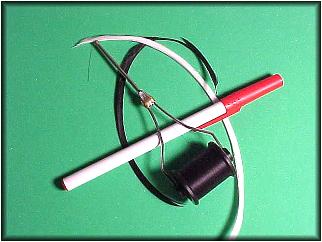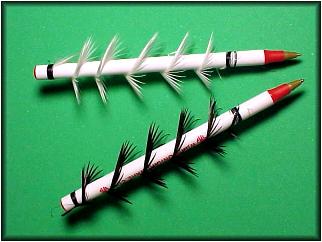
Goose Biots. They tend so effectually to bring a sense of realism to many of our flies,
particularly those which represent the nymphal stage of the mayfly.
The Prince Nymph is an excellent representation of the employment of Goose Biots in
the construction of a very productive fly.
Tying this particular fly is no real mystery. Like all of the tiers art, materials are applied in
sequence to the hook in order that the pattern may be produced and reproduced.
In the beginning many of us struggled with various stages of the tying operation, and
this is essentially necessary to becoming a proficient tier. After all, even Lee Wulff had
dues to pay!
One area where we can have a large impact on your success at the bench is in the
preparation of the materials we are going to use.
Of all of these neat little tricks, I really like this one. It sped up my tying of Prince Nymphs,
and allowed me to concentrate on "creating" rather than simply being mechanical in my tying.
It is funny, but as we become experienced, we do not necessarily become more creative. The
creativity was always there, but it was forced to play second fiddle to mechanical things which
required the bulk of our concentration.
Biots, by their nature are a bit difficult as they come from the goose quill. They tend to
appear as one with the quill when it has been split from the feather. They consume a fair
amount of time to separate and cut from the quill as we tie. Actually it would be accurate
to suggest a totally disproportionate amount of time.
We can however make the use of this wonderful material not only more practical, but
a bit of fun as well.
Now, take an old (or new, your choice) ball point pen, or a lead pencil, or a dowel, and
hold one end of the biot quill against the shaft while with your bobbin you secure it to
the shaft with 20 or so thread wraps. Using your hand whip finish, tie off.
Now, and this is the neat part, wind the quill in open spirals around the shaft and tie wrap
the other end with the thread and tie off.

You now have a neat little "Goose Biot Tree." With the point in one end of your shaft you
can now stick or "plant" your tree in your Styrofoam tool holder, or a scrap block of
Styrofoam.
If you will now take whatever color Biots your pattern requires and prepare them in this
manner you will have a very neat way of keeping them handy for selection and harvest
as your fly requires.
They also can be used in place of flowers to brighten up your bench a bit. Why you could
have your very own little forest of Biot Trees.
No more excuses, the Prince Nymph has now been simplified beyond our wildest dreams,
so get tying!
If you have any tips or techniques, send them along, most of this
material has been stolen from somebody, might as well steal your ideas
too!~ George E. Emanuel
(Chat Room Host Muddler)
|



